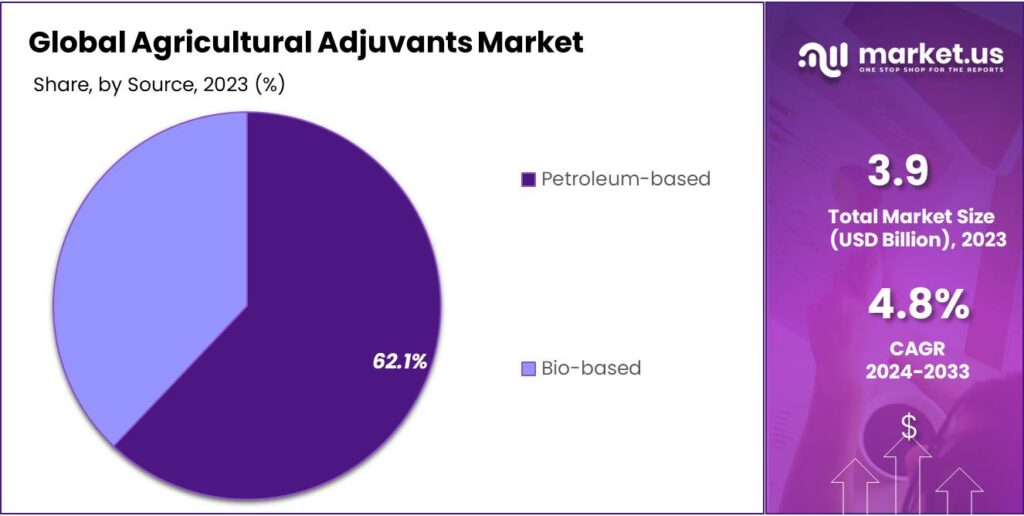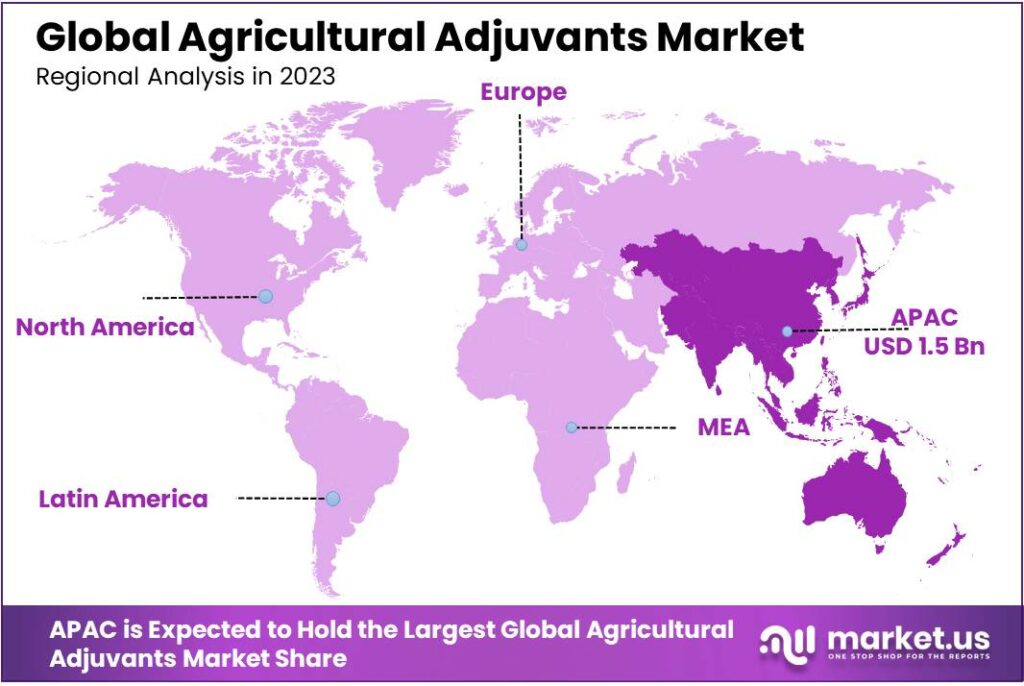Global Agricultural Adjuvants Market By Type (Activator Adjuvants and Utility Adjuvants), By Application (Herbicides, Insecticides, Fungicides, and Others), By Crop (Cereal & Grains, Oilseeds & Pulses, Fruits & Vegetables, and Others), By Region and Companies - Industry Segment Outlook, Market Assessment, Competition Scenario, Trends and Forecast 2023-2033
- Published date: Nov 2023
- Report ID: 14787
- Number of Pages: 254
- Format:
- keyboard_arrow_up
Quick Navigation
Market Overview
The global Agricultural Adjuvant market size is expected to be worth around USD 6.2 billion by 2033, from USD 3.9 billion in 2023, growing at a CAGR of 4.8% during the forecast period from 2023 to 2033.
The Agricultural Adjuvant market is a dynamic landscape that plays a crucial role in modern farming practices. These adjuvants are additives formulated to enhance the efficiency and performance of pesticides, herbicides, and fertilizers.
In 2023, this market experienced robust growth owing to the increasing demand for enhanced crop yields and more effective agricultural solutions.

*Actual Numbers Might Vary In The Final Report
Key Takeaways
- Market Growth Projection: The global Agricultural Adjuvants market is estimated to reach approximately USD 6.2 billion by 2033 from USD 3.9 billion in 2023, exhibiting a 4.8% CAGR during the forecast period.
- Type Analysis: Activator Adjuvants: Dominated the market with a 70.3% share in 2023. They’re extensively used due to availability and cost-effectiveness, particularly as surfactants and oil carriers, enhancing the efficiency of herbicides. Utility Adjuvants: Expected to grow at a 3.5% CAGR due to increased pesticide use, offering various types including compatibility agents, drift control agents, buffering, and water conditioning agents.
- Application Analysis: Herbicides: Contributed 46.7% to global revenue in 2023, widely used in the agricultural sector to control weeds and undesirable plants. Insecticides: Expected to grow at a 4.7% rate due to increased demand for various crops like cereals, grains, and fruits.
- Source of Adjuvants: Petroleum-based: Held 62.1% of the market in 2023 due to effectiveness, affordability, and widespread availability. Bio-based: Showed promising growth, accounting for 37.9%, reflecting an increasing preference for environmentally friendly options.
- Crop Analysis: Cereal & Grains: Contributed 40.3% to the revenue, witnessing increased demand globally, especially in the Asia Pacific region, due to the consumption of wheat, rye corn, oats, and sorghum.
- Regional Analysis: Asia Pacific: Dominated the market with a 38% share in 2023 due to increasing demand for improved crops, a rising population, and large arable land in countries like China, India, and Japan. North America: Projected to expand at a 2.7% growth rate owing to increased agricultural focus, especially in countries like the US and Canada, adopting new techniques like precision farming.
- Market Share Analysis: The market is highly competitive with local and Tier-I players, focusing on factors like product quality, innovation, sustainability, and corporate reputation to enhance market share. Key strategies include innovation, product launches, geographic expansion, joint ventures, and mergers & acquisitions.
- Key Market Players: Major players include Huntsman International LLC, Croda International PLC, Corteva Agriscience, Clariant AG, Nufarm Limited, BASF SE, Solvay SA, and others.
Type Analysis
The global market share for agricultural adjuvants in 2023 was 70.3% led by the activator adjuvants category. Due to their availability and low cost, they are often used extensively in agrochemicals.
These activator adjuvants can be surfactants and oil carriers. Surfactants are most often recommended adjuvants to herbicides, mainly for water-soluble and systemic herbicides.
Because of the increased use of pesticides to reduce unwanted things in the cropland, the utility adjuvants segment will grow at a 3.5% CAGR over the forecast period. There are many types available depending on the purpose of the utility adjuvant. There are several key utility adjuvants, including compatibility agents. Drift control agents, buffering, and water conditioning agents.
Application Analysis
In 2023, 46.7% of global revenue was contributed by herbicides to the market for agricultural adjuvants. In the agricultural sector, herbicides are a common pesticide. They can be used for controlling weeds, as well as other undesirable plants. FAO reports that more than 2,000,000 tons of herbicides were used worldwide in 2023.
Insecticide sales are expected to increase at a rate of 4.7% during the forecast period. This is due to increased demand for many crops like cereals, grains, and fruits. They have been proven to be effective in preventing pest attacks from early germination in many crops.
By Source
In 2023, Petroleum Based was the big leader in the Agricultural Adjuvants Market, grabbing over 62.1% of the pie. Farmers preferred these due to their effectiveness.
Bio-based adjuvants, on the other hand, showed promising growth. With around 37.9% of the market, they gained traction among eco-conscious consumers seeking sustainable solutions.
Petroleum-based adjuvants have been ruling due to their affordability and widespread availability. However, bio-based options are gaining ground as people prioritize environmentally friendly products. This shift indicates a potential change in consumer preferences in the agricultural sector.

*Actual Numbers Might Vary In The Final Report
Crop Analysis
Globally, 40.3% of agricultural adjuvants revenue was contributed by the cereal and grains market. Cereals are the most popular crop class, with the majority of them being consumed in the Asia Pacific. There is a growing need for agricultural adjuvants due to the rising consumption of cereals and grains, including wheat, rye corn, oats, and sorghum in other regions. Agrochemicals, as well as non-ionic surfactants, should be used for grains and cereals.
Key Market Segments
Type
- Activator Adjuvants
- Surfactants
- Oil-based Adjuvants
- Utility Adjuvants
- Compatibility Agents
- Drift Control Agents
- Buffering Agents
- Water Conditioning Agents
- Others
Application
- Herbicides
- Insecticides
- Fungicides
- Others
By Source
- Petroleum-based
- Bio-based
Crop
- Cereal & Grains
- Oilseeds & Pulses
- Fruits & Vegetables
- Others
Regional Analysis
The Asia Pacific dominated global agricultural adjuvants markets and held a 38% share in global revenue for 2023. This was due to many factors such as increasing demand for improved crops, rising population, and the presence of large arable countries.
The agricultural sector is the main driver of the region’s per capita income. The area’s total arable surface is shrinking due to increased urbanization and industrialization. Agriculturists, therefore, choose agrochemicals that increase yield and productivity. Major contributors to regional market expansion are China, India, and Japan.
According to the Organization for Economic Co-operation and Development and Food and Agricultural Organization, Asia Pacific is the world’s largest producer of agricultural commodities. Up to 53% of the world’s agricultural products and fish production will come from the Asia Pacific by 2032.
North America is projected to expand at a revenue-based growth rate of 2.7% over the forecast time. This can be explained by the increased focus on agriculture activities in countries like Canada and the U.S. It is expected that the adoption of new techniques, such as precision farms, will increase the demand in the region for agrochemicals.

*Actual Numbers Might Vary In The Final Report
Key Regions and Countries
- North America
- US
- Canada
- Mexico
- Europe
- Germany
- UK
- France
- Italy
- Russia
- Spain
- Rest of Europe
- APAC
- China
- Japan
- South Korea
- India
- Rest of Asia-Pacific
- South America
- Brazil
- Argentina
- Rest of South America
- MEA
- GCC
- South Africa
- Israel
- Rest of MEA
Because of the large number of local and Tier-I players, the market for agricultural adjuvants can be highly competitive. There are many manufacturers in this market that offer agricultural adjuvants. These include utility and activity adjuvants.
They can be used for a variety of applications like herbicides or insecticides. There are many factors that influence the market’s competitiveness, including product quality, innovation, sustainability, and corporate reputation.
The key strategies of market players are innovation, product launches, geographic expansion, expansion of distribution networks, joint ventures, and mergers & acquisitions. These strategies help them to increase their market share and strengthen their market position. Clariant AG, for example, launched NBP in May 2020. It is a new formulation of polar aprotic solvent to be used in agricultural adjuvants Genagen formulations.
Key Market Players
- Huntsman International LLC
- Croda International PLC
- Corteva Agriscience
- Clariant AG
- Nufarm Limited
- BASF SE
- Solvay SA
- The Dow Chemical Company
- Ingevity
- Stepan Company
- Miller Chemical & Fertilizer, LLC.
- Helena Chemical Company
- Winfield United
- Wilbur-Ellis Holdings, Inc.
- Evonik Industries AG
Recent Development
In April 2022, Lamberti SPA acquired UK-based Turftech International, a company developing and selling special surfactants for applications in horticulture and turf. The acquisition helps Lamberti to expand and diversify its product portfolio and market share in the region.
Report Scope
Report Features Description Market Value (2022) USD 3.9 Bn Forecast Revenue (2032) USD 6.2 Bn CAGR (2023-2032) 4.8% Base Year for Estimation 2022 Historic Period 2016-2022 Forecast Period 2023-2032 Report Coverage Revenue Forecast, Market Dynamics, COVID-19 Impact, Company Profiles, Recent Developments Segments Covered By Product (Activator Adjuvants, Utility Adjuvants), By Application (Herbicides, Insecticides, Fungicides, Others), By Source (Petroleum-based, Bio-based), By Crops Type (Cereals & Grains, Oilseeds & Pulses, Fruits & Vegetables, Others) Regional Analysis North America – The US, Canada, & Mexico; Western Europe – Germany, France, The UK, Spain, Italy, Portugal, Ireland, Austria, Switzerland, Benelux, Nordic, & Rest of Western Europe; Eastern Europe – Russia, Poland, The Czech Republic, Greece, & Rest of Eastern Europe; APAC – China, Japan, South Korea, India, Australia & New Zealand, Indonesia, Malaysia, Philippines, Singapore, Thailand, Vietnam, & Rest of APAC; Latin America – Brazil, Colombia, Chile, Argentina, Costa Rica, & Rest of Latin America; The Middle East & Africa – Algeria, Egypt, Israel, Kuwait, Nigeria, Saudi Arabia, South Africa, Turkey, United Arab Emirates, & Rest of MEA. Competitive Landscape SUEZ, BASF SE, Ecolab, Solenis, Nouryon, Kemira Oyj, Dow Chemical Company, SNF Group, Cortec Corporation, Buckman, Solvay S.A., Other Key Players. Customization Scope Customization for segments, region/country-level will be provided. Moreover, additional customization can be done based on the requirements. Purchase Options We have three licenses to opt for: Single User License, Multi-User License (Up to 5 Users), Corporate Use License (Unlimited User and Printable PDF). Frequently Asked Questions (FAQ)
Why are Agricultural Adjuvants Used?Farmers use agricultural adjuvants to optimize the performance of agrochemicals. They help in better distribution, adhesion, and absorption of pesticides and other agricultural inputs onto plant surfaces, resulting in improved effectiveness and reduced wastage.
How is the Market Evolving?The market is witnessing a transition towards more sustainable and eco-friendly solutions. While petroleum-based adjuvants have historically dominated the market, bio-based alternatives are gaining momentum due to increased environmental awareness and stringent regulations promoting sustainable agriculture.
What is the Future Outlook for the Agricultural Adjuvants Market? Agricultural Adjuvants MarketPublished date: Nov 2023add_shopping_cartBuy Now get_appDownload Sample
Agricultural Adjuvants MarketPublished date: Nov 2023add_shopping_cartBuy Now get_appDownload Sample - Huntsman International LLC
- Croda International PLC
- Corteva Agriscience
- Clariant AG Company Profile
- Nufarm Limited
- BASF SE Company Profile
- Solvay SA
- The Dow Chemical Company
- Ingevity
- Stepan Company
- Miller Chemical & Fertilizer, LLC.
- Helena Chemical Company
- Winfield United
- Wilbur-Ellis Holdings, Inc.
- Evonik Industries AG
- Nestlé S.A Company Profile
- settingsSettings
Our Clients
| Single User $4,599 $3,499 USD / per unit save 24% | Multi User $5,999 $4,299 USD / per unit save 28% | Corporate User $7,299 $4,999 USD / per unit save 32% | |
|---|---|---|---|
| e-Access | |||
| Report Library Access | |||
| Data Set (Excel) | |||
| Company Profile Library Access | |||
| Interactive Dashboard | |||
| Free Custumization | No | up to 10 hrs work | up to 30 hrs work |
| Accessibility | 1 User | 2-5 User | Unlimited |
| Analyst Support | up to 20 hrs | up to 40 hrs | up to 50 hrs |
| Benefit | Up to 20% off on next purchase | Up to 25% off on next purchase | Up to 30% off on next purchase |
| Buy Now ($ 3,499) | Buy Now ($ 4,299) | Buy Now ($ 4,999) |












